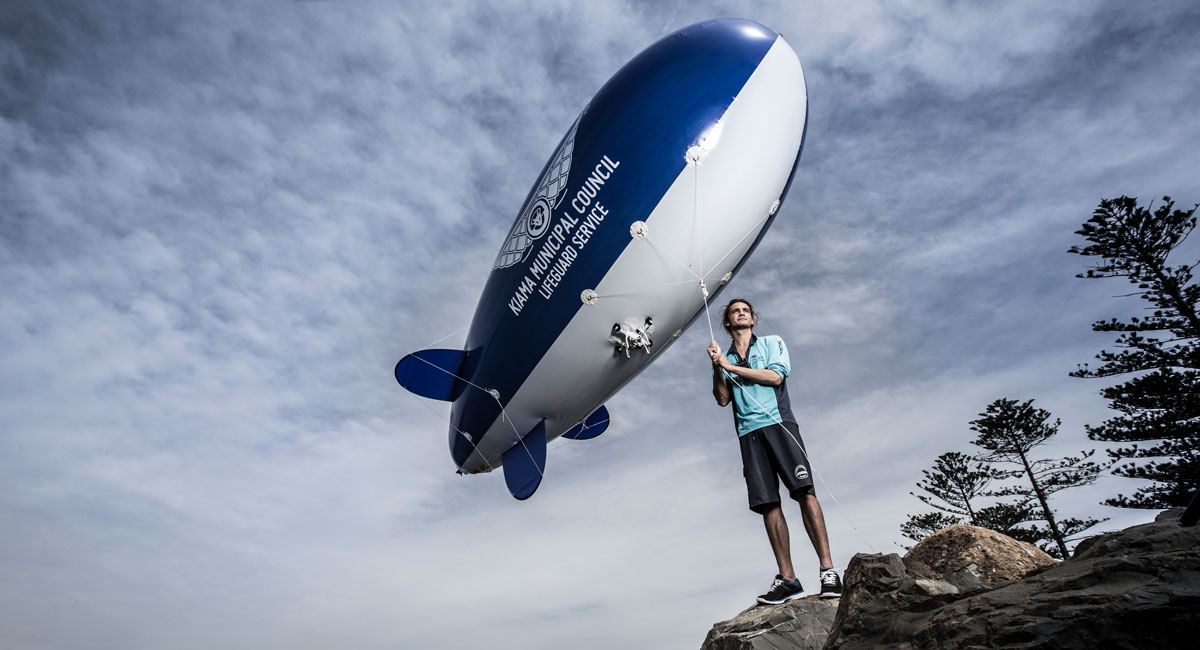January 29, 2018
Eye in the sky keeps beachgoers safe over summer
Shark-spotting blimp trial wraps up a second season of trials.
A project designed to help alert swimmers and lifeguards to the presence of sharks has been hailed a success, after logging more than 200 hours watching over Surf Beach Kiama.
Project AIRSHIP, a collaboration between University of Wollongong marine biology PhD student Kye Adams and Kiama Council lifeguards, involves a live-streaming video camera attached to a blimp that hovers for hours at a time over popular beaches.
A live feed to researchers on the ground allows them to alert swimmers to any sharks in the area.
During its second season, the system demonstrated its capacity when it alerted beachgoers to the presence of two grey nurse sharks feeding on a large school of fish.
The blimp operator was able to continuously monitor the sharks as they moved around the beach and assisted Lifeguards in their decision to re-open the beach when the fish activity moved offshore.
Kye said the footage was also providing valuable insights into the behaviour of other sea life, including curious stingrays, seals and dolphins.
“Sharks have been a rare occurrence at the monitored beach this summer with only a few spotted in conjunction with schooling fish,” he said.
“In contrast, numerous stingrays have been spotted on more than 40 occasions swimming close to the beach.
“We have been able to record their movements within this beach and can seek to ask further questions of how these animals utilise these areas.
"The blimp has been successful in spotting other large and mobile species with a few visits from a number of playful seals and dolphins.”
During the 2017-18 season, Project AIRSHIP was supported by the Save Our Seas Foundation and UOW’s Global Challenges Program, two programs that aim to better understand and sustain marine life.
“This summer it's been great to show the public that dangerous sharks at our beaches down on the south coast are quite rare compared to other marine creatures.
“We've been able to successfully show that the blimp can reliably detect a range of marine life, including sharks, seals, stingrays and baitfish,” Kye said.
“To see the grey nurses was quite special considering they are an endangered species and we could watch them on the camera knowing swimmers were not in any danger.
"It's great to know that we are providing a real level of safety to beachgoers.”
Kiama Municipal Council has also provided ongoing logistical support through its lifeguarding service.
In addition to the shark spotting, the aerial view provides lifeguards with an additional view of beach hazards, such as rips and swimmers in distress, providing a tool to support lifeguards in providing safer swimming areas.
“With the University and the Department of Primary Industries we are in the process of developing automated shark detection algorithms that will have the capacity to send alerts to swimmers and surfers smart watches if a shark is spotted,” Kye said.
“Basically, we are teaching the blimp to spot sharks on its own and giving it the ability to alert beachgoers in real time.”
Learn more about Project AIRSHIP at UOW's Global Challenges Program.
